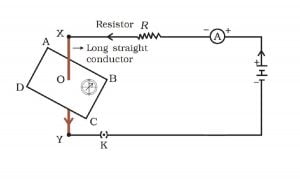Activity Solution Chapter 13 Magnetic Effects of Electric Current.
In chapter 12, we studied electric current. In this chapter, we study the magnetic effects produced by the current. Below is the explanation of various activities with the conclusion for this chapter.
Contents:
- Activity 13.1 Class 10 Science: The flow of charge or current produces a magnetic effect:
- Activity 13.2 Class 10 Science: The magnetic field of a magnet has a fixed shape.
- Activity 13.3 Class 10 Science: Magnetic filed is a vector quantity.
- Activity 13.4 Class 10 Science: Magnetic filed is a vector quantity.
- Science Class 10 Content List.
Table of Contents
Activity Solution 13.1 Class 10 Science Chapter 13

Observation: Compass needle deflects when electricity passes through the copper wire.
Explanation:
Whenever there is a change in the current, it produces an electric field. In normal usage, a compass detects the magnetic field of the earth. When we bring the compass near a wire and pass current, an artificial magnetic filed produces. This artificial magnetic field deflects the compass.
Note: This is one of the fundamental property of the current. It was discovered accidently by Oersted using the same experiment. This discovery led to the invention of many devices like the radio, TV, etc. So, in his honor, we call the unit of a magnetic field as Oersted ‘O‘.
Conclusion: This phenomenon shows the relationship between the current flowing through a wire and its magnetic effect. It shows that a current produces magnetic filed which deflect the compass.
Activity Solution 13.2 Class 10 Science Chapter 13
Observation: Iron filings arrange themselves in a fixed parabolic pattern.
Explanation: A bar magnet attracts iron particles. This force of attraction differs from place to place near a magnet and forms a magnetic field of characteristic shape. When we dust the iron filings, iron particles arrange themselves in a fixed pattern as per the nearby magnetic field.
Conclusion: A magnet has a magnetic field in its surrounding which differ from place to place.
Activity Solution Chapter 13 Magnetic Effects of Electric Current by Studdy
Activity Solution 13.3 Class 10 Science Chapter 13
Observation: The compass needle always remains in one direction i.e. North pole of the needle always point towards the south.
Explanation: A magnet consists of two opposite poles: the north and the south. A compass needle is also a small bar magnet. It also has a north as well as a south pole. North pole of a magnet attracts south
Conclusion: Here we see that poles of a magnet attract the opposite poles only. This means the magnetic field has a direction. For convention, we assume the magnetic field emerges from the north and goes into the south.
Activity Solution 13.4 Class 10 Science Chapter 13
Brief Procedure: Activity 13.4 asks us to change the direction of current in a wire and see the deflection in the compass.
Observation: When we reverse the direction of the current, compass needle also reverses its direction.
If current flows from north to south, the direction of the needle is east; similarly, if the direction of current is reversed the direction of compass point towards west.
Explanation:
When we pass current into a wire, it produces a magnetic field. This field is perpendicular to the direction of the current. So, if current flows from north to south, east becomes the north pole of the magnetic field. In such a situation the south pole of magnet aligns with the north pole and see compass directing towards the east.
Similarly, if we change the direction of the current by changing the terminals of the battery, the direction of current reverses. This results in the production of a magnetic field in the opposite direction. As a result, the compass also reverses its direction.
Conclusion: Magnetic filed is a vector quantity.
Note: We can use Right thumb rule to find the direction: Palm on the plane and movement of fingers in the direction of the current gives thumb as North pole.
Activity Solution 13.5 Class 10 Science Chapter 13
Ncert class 10 Science solutions
1. Chemical Reactions and Equations
8. How do Organisms Reproduce?
10. Light – Reflection and Refraction.
13. Magnetic Effects of Electric Current.
Ref: NCERT Science Class 10.
There is no 13.5 activitiy procedure observation explanation conclusion
Science
Class 10
I want to learn activity 13.5 to13.8 or 13.9
there is no explanation of activity 13.54